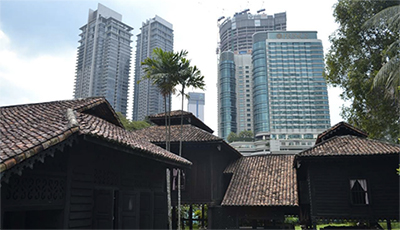In this section, Prof. Lawrence Susskind shares how the Malaysia Sustainable Cities Program began and describes the groups of scholars, students, and administrative support staff involved in implementing the program.

Traditional Malay house contrasted with high-rise development in Kuala Lumpur. (Image courtesy of Marcell Williams. Used with permission.)
Documenting Malaysia’s Rapid Development
The Malayasia Sustainable Cities Program began when the Vice-Chancellor of the Universiti Teknologi Malaysia (UTM), Dr. Zaini Ujang, participated in the one week Water Diplomacy Workshop co-chaired by MIT Professor Larry Susskind and Tufts University Professor Shafik Islam. Through Dr. Ujang, we heard the story of Malaysia’s current efforts to promote sustainable city development. He then became Deputy Secretary General of Higher Education for Malaysia. He encouraged us to engage MIT and UTM faculty and students in helping to document Malaysia’s commitment to become a “developed” as opposed to a “developing,” country and Malaysia’s commitment to becoming a low carbon society in less than 15 years.
Involving Visiting International Scholars
We chose to involve scholars from the Global South in producing the documentation Dr. Ujang recommended. We determined that if Malaysia could provide instructive examples to other developing countries, it would make the most sense for these stories to be told by international scholars from the Global South. With support from the Malaysian Ministry of Education, we were able to identify the funds needed to bring ten visiting international scholars to UTM for a half year to pursue very specific research questions. Then, they were invited to spend a half year at MIT, transforming their research findings into publishable papers and teaching videos (designed to be distributed world-wide to support the teaching of sustainable development in colleges and universities in the Global South). We received a five-year grant to support all of these activities, and in September 2016 the third cohort of international scholars arrived at UTM.
Engaging MIT Graduate Students and Faculty
Graduate students and faculty from the MIT Department of Urban Studies and Planning (DUSP) spend two weeks in Malaysia during the Independent Activities Period (IAP) in January. After an orientation to urban and environmental planning in Malaysia, MIT students and faculty are joined by UTM students and faculty. They visit the five cities on which we are focusing: Kuala Lumpur (KL), Johor Bahru (JB), Georgetown, in the state of Penang; Serang in East Malaysia; and Putrajaya (the high-tech capital city of Malaysia). They meet with government and non-governmental leaders in each city to gauge the progress in achieving very specific sustainable development objectives. Their goal in each city is to identify research questions that the next cohort of visiting international scholars ought to address. When the Practicum students return from MIT, they spend the last week of IAP drafting the annual Practicum Report, which includes their recommendations. The draft is shared with the UTM faculty and the current international fellows before it is finalized. Once it is put online, applicants for the next year’s cohort of visiting scholars must select a research question from the Practicum Report. This allows each new cohort of scholars to know who they can work with in Malaysia from the day they arrive.
Each year’s visiting international scholars join the IAP Practicum as part of the teaching faculty. As noted above, in the spring, when they are at MIT, they work with MIT doctoral students and faculty to prepare research papers to submit to peer-reviewed journals (in their separate fields) and produce teaching videos for global distribution. To ensure they have the photographic and video materials they need for their teaching videos, they spend considerable time during the Fall semester, with the help of a professional videographer, collecting imagery at multiple locations. Almost all the scholars work in conjunction with government agencies, community organizations, or private companies (identified by the preceding Practicum) to gather the information they need to answer their research questions about the obstacles to achieving sustainable city development and the successes that Malaysia has had. During the spring, while they are at MIT, the visiting Scholars are part of the MIT Science Impact Collaborative (in DUSP) and participate as guests in graduate classes. They also give formal presentations of their work in progress open to the whole campus.
Orchestrating Ongoing International Learning Experiences
The logistics of moving 15 students all around Malaysia so they can visit 5 cities and meet with key officials and community leaders in each place presents logistical and preparatory challenges.
— Lawrence Susskind
As you can imagine, it is not easy to organize a two-week practicum in another country every January. The cost is about $60,000. We try to include 15 graduate students, most from DUSP, but a few from other parts of the Institute. We include three or four DUSP faculty members. The logistics of moving 15 students all around Malaysia so they can visit 5 cities and meet with key officials and community leaders in each place presents logistical and preparatory challenges. Everything has to be coordinated between MIT, UTM and the national government in Malaysia. We have program assistants at both universities.
In addition to the Practicum, organizing a one-semester residency in Malaysia and a one semester residency in Cambridge, MA for then visiting scholars from all over the world requires an enormous commitment of time and administrative resources. Integrating the visiting scholars into the research activities of faculties at two universities requires constant attention. Providing them with the support they need to do their research and produce instructional videos while they are at MIT involves a very elaborate team of video production experts. I think we have become better each year at figuring out how to shape expectations and ensure that everyone has the information and the support they need at the time they need it. MIT and UTM administrative staff are the key to this.
